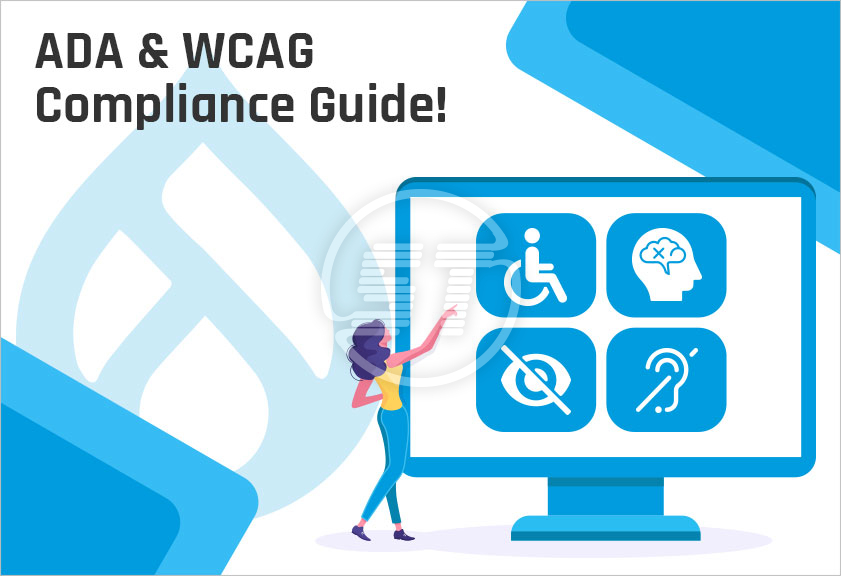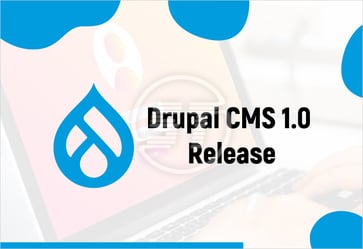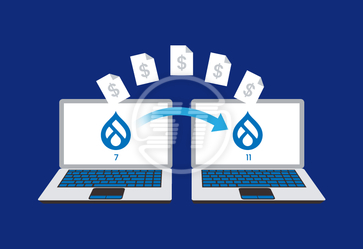“The power of the Web is in its universality. Access by everyone regardless of disability is an essential aspect”
Web accessibility to everyone has become one of the main tenets of the digital industry today and with over 15% of the global population having some form of disability, the need for inclusive websites has never been more important!
In the current pandemic situation, people are flocking to the eCommerce, online healthcare, and learning websites. It became glaringly clear that many businesses were not ready to meet the demand for accessible websites and software. As a result, even the ADA compliant lawsuits soared.
Learn about how Drupal websites are ADA and WCAG compliant with this guide to Web Accessibility.
What is Web Accessibility?
Web accessibility refers to the design and development of websites and web tools so that people with disabilities can use them. However, many website applications and tools are developed with accessibility barriers that create hindrances for some people, making the web,a non-inclusive space.To make the internet a more accessible space, we should accommodate all website users including those who have difficulty navigating the web.
Web accessibility encompasses all disabilities such as visual impairment, color blindness, auditory impairment, cognitive disabilities, speech, and neurological issues that may make the internet a more daunting place. There could also be some situational disabilities like broken arms too which could be temporary.
What is ADA?
The Americans with Disabilities Act (ADA) says that businesses must provide access to their products and services for people of all abilities. This act extends into the digital world as well as the physical storefront. It is important to make sure your business provides equal access for everyone, which also expands your business reach.
What is WCAG?
WCAG(Web Content Accessibility Guidelines) was developed by the W3C(World Wide Web Consortium) as a set of rules and regulations that help the digital content accessible to all the users, including those with disabilities. The websites have to follow four basic principles - perceivable, robust, operable, and understandable in order to be WCAG compliant.
A Beginner’s Guide to Drupal ADA and WCAG Website Accessibility Compliance
Drupal CMS, as a platform, has been built to adhere to both the ADA and WCAG guidelines. It provides the ability to organize and manage web content in a systematic manner. The Drupal community is one of the most collaborative in the world with a set of shared values like breaking the accessibility barriers on the web. They build Drupal websites by strictly adhering to the code standards and semantic markup. They also have an accessibility team that identifies any barriers both at the code and awareness levels and resolve them. The team’s primary objective is to ensure that any person using assistive technologies to browse the web to have a seamless experience with Drupal websites.
The developer community finds Drupal a great place to start with as it already has extensive support for accessibility standards. Developers can pledge to build themes and modules under the accessibility rules. Semantic HTML5 is a part of Drupal core and hence Drupal websites now adopt more WAI-ARIA practices, which makes content structures easier to understand for people with disabilities. This means that site pages are more semantically correct and visually impaired users will find it much easier to use your site.
Drupal Accessibility Toolkit
When you develop and design websites using Drupal, evaluation of accessibility starts right from the beginning and continues throughout the development process. It has got all the semantic markup and templates like article tag, section tag, alt tag, and other HTML tags that improve web accessibility. Some of the features and modules are discussed here-
1. New accessible front-end theme Olivero - This theme is introduced in June 2020 and it is fully WCAG compliant. Olivero theme is created with the cooperation of the best accessibility experts, and thoroughly tested considering the accessibility feedback.
2. Semantic Elements - HTML semantic elements allow developers to assign a name that fits the purpose of an element. Drupal considers this point to provide a common element name for users and machines to know what is expected. Examples include <article>, <section>, <header>, >footer< and more.
3. Better Contrast - Users with color blindness can easily use your websites with improved contrasts. This is also useful when you are using your portable device like a tab or mobile phone under bright sunlight.
4. Inline Form Errors - Drupal 8 provides a better form validation error verbiage to improve accessibility related to the display of form errors. For example, a visually impaired person can easily identify the form errors he might have made while filling it.
5. Buttons Instead of Links - Drupal started to use a button rather than anchor texts as these UI elements are action-oriented.
6. Aural alerts - Some changes that take place on the page may go unnoticed by the screen readers and the Aural alerts allow you to inform them about these changes with a message that they need to readout.
7. Alt Text - Drupal sets it to ‘required’ by default and it refers to the appropriate description of the image. It is used by the screen readers and usually not rendered in the display of the page.
Other Accessibility Features include -
Layout Builder Module - This is fully compliant with WCAG guidelines and it offers easy and powerful page-building capabilities allowing website builders to build custom pages, create reusable templates, granular customizations, and much more.
CKEditor Accessibility Checker Module - This module allows you to test the accessibility level of your website content. CKEditor complies with industry standards and always generates code with semantic markup.
SiteImprove Module - This module provides a plugin to connect your Drupal website to the Siteimprove intelligence platform which is a digital presence optimization software that provides you amazing insights in improving web accessibility compliance. It also helps improve website traffic, performance, content quality, and more.
Text Resize Module - This module allows the users to alter the font size of the web pages with a just click of a button. Visually impaired users find it easier as they can adjust the size of the text that suits their eyesight.
Style Switcher - It provides alternate stylesheets that can be seen in the admin dashboard and the users can choose the style they want to view the page.
htmLawed and HTML Purifier - While the former module provides a clean HTML which is screen-friendly and HTML purifier uses a standard-compliant HTML filter library to take care of the clean HTML for web accessibility.
How do I know that Drupal Website is ADA compliant?
There are a number of ways to ensure that your website is ADA compliant.
1. Manual Inspection
Manually inspect your website and make changes according to the ADA/WCAG guidelines. Check the semantic markup and styling on your site to see if it meets the criteria. The most common areas that require manual inspection is labeling - section labels, navigation labels, and other parts of a site that describe the functionality and intent behind the content or markup.
2. Using Tools
There are various tools for accessibility checks and validations. W3C Validator and Chrome DevTools are some which can help you check the accessibility of your website.
3. Audit We, at Skynet Technologies USA LLC, offer audits regarding Drupal ADA compliance. These audits are so diligent that we could help you fix the issues in some of the most critical components.
How Drupal ADA Compliant Benefits Your Business
With an increased focus placed on accessibility, it’s good to be aware of the value it brings in addition to knowing the efforts and skills required to implement it. There are many aspects in which prioritizing accessibility benefits a business, ranging from basic compassion to legal obligations.
Here’s a look at some of the major benefits of having a website that follows Drupal ADA compliance rules.
1. Wider Audience Reach
Drupal Web Accessibility provides equal access to the people who otherwise would have found it difficult to use your website, resulting in an increased audience. This not only widens your reach but also builds a web of loyal customers and a potential rise in sales.
2. Improves your Brand Reputation
Having ADA compliant options to your website shows your customers that you care. With hundreds of competitors out in the market, there needs to be a reason your business stands out from the crowd. Not all websites are ADA website compliant, so going the extra mile to add the features to your site can set you apart from the crowd. Customers who rely on these features will know your business is accessible and will come back in the future too.
3. Better User Experience
Features intended for users with permanent/temporary disabilities actually improve the overall user experience. In fact, accessibility is the prerequisite of user experience. By internalizing the accessibility factor, businesses design and develop great digital experiences for users.
4. Optimized SEO Strategy
Drupal websites follow the best practices like semantic markup and sitemaps which allow the search engine crawlers to better index the site and improves the chances of achieving favorable rankings in SERP results. It’s only in 2016, Google started to penalize the non-responsive websites, and going by that, one shouldn’t be surprised if accessibility and semantic web become the next things in the SEO strategy.
5. Drupal ADA Compliant Helps Avoid Major Lawsuits
Websites that are not Drupal ADA compliant are breaking the law, and the number of lawsuits has risen dramatically over the past few years. By staying under the guidelines of ADA and WCAG, you can save your liable expenses down the road.
Conclusion
In this guide, we have seen how web accessibility is ingrained in Drupal’s principles and values. There are many companies racing to assist their clients with improved templates, customization, and modules to make accessibility enhancements easier. But in the end, it is up to the organizations to strategize and build web applications around the web accessibility. We, at Skynet Technologies USA LLC, make accessibility an integral part of design and development, rather than just a necessary but cumbersome afterthought.
Skynet Technologies USA LLC is a full-service provider of ADA Compliant Website Design, Accessibility Web Development, ADA Compliance Audit, ADA Compliance Mobile App and other ADA Compliance Services. We can make Drupal, WordPress, Magento Website or Mobile app an ADA Compliant.


